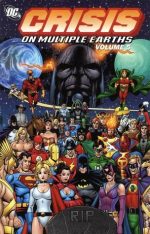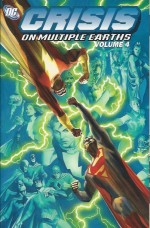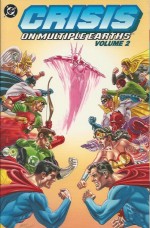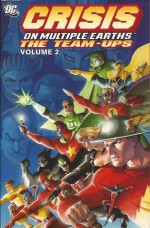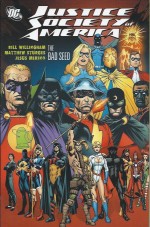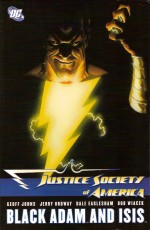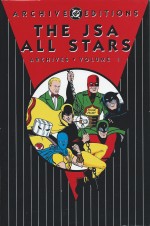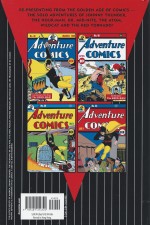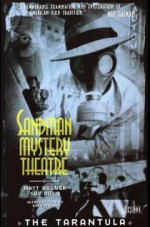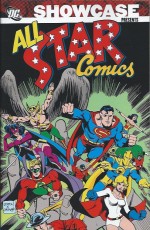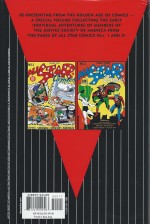
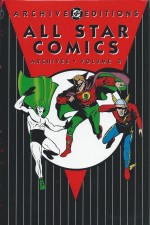
By Gardner Fox, Jerry Siegel, Ken Fitch, Bill Finger, John B. Wentworth, Sheldon Moldoff, Sheldon Mayer, Albert & Joseph Sulman, Creig Flessel, Jon L. Blummer, Martin Nodell, E.E. Hibbard, Chad Grothkopf, Stan Aschmeier, Bernard Baily, Howard Purcell, William Smith & various (DC Comics)
ISBN: 978-1-4012-0791-X
I will never stop saying it: the creation of the Justice Society of America in 1941 utterly changed the shape of the budding comicbook industry. However before that team of All-Stars could unite they had to become popular enough to qualify, and this slim yet superb hardcover sampler gathers a selection of individual exploits featuring many of the soon-to-be beloved champions who would populate the original big team and guarantee their immortality long after the Golden Age of American Comics ended.
Following the runaway successes of Superman and Batman, both National Comics and its wholly separate-but-equal publishing partner All-American Comics were looking for the next big thing in funnybooks whilst frantically concentrating on getting anthology packages into the hands of the hungry readership. Thus All Star Comics: conceived as a joint venture to give the characters already in their stables an extra push towards winning an elusive but lucrative solo title.
As scrupulously detailed in Roy Thomas’s history-packed Foreword, characters from Flash Comics, Adventure Comics, More Fun Comics and All-American Comics were bundled into the new quarterly and ‘A Message from the Editors’ asked readers to vote on the most popular, even offering copies of forthcoming issues as prizes/bribes for participating…
The merits of the project would never be proved: rather than a runaway favourite graduating to their own starring vehicle, something different evolved. With the third issue, prolific scripter Gardner Fox apparently had the smart idea of linking the solo stories through a framing sequence as the heroes got together for dinner and a chat about their most recent cases.
With the simple idea that Mystery Men hung around together, history was made and from #4 the heroes would regularly unite to battle a shared foe…
This slim sublime hardcover tome collects the stories from the first two All Star Comics (cover-dated Summer and Fall 1940) and opens with a tale of a fantastic winged warrior…
Although perhaps one of DC’s most resilient and certainly their most visually iconic character, iterations of Hawkman have always struggled to find enough of an audience to sustain a solo title.
From his beginnings as one of the B-features in Flash Comics, Carter Hall has shone through assorted engaging, exciting but always short-lived reconfigurations. Over decades from ancient hero to re-imagined alien space-cop and post-Crisis on Infinite Earths freedom fighter, or the seemingly desperate but highly readable mashing together of all previous iterations into the reincarnating immortal berserker-warrior of today, the Pinioned Paladin has performed exemplary service without ever really making it to the big time.
Created by Gardner Fox & Dennis Neville, he premiered in Flash Comics #1 (January 1940) and stayed there, growing in quality and prestige until the title died, with the most celebrated artists to have drawn the Winged Wonder being Sheldon Moldoff and Joe Kubert, whilst a young Robert Kanigher was justly proud of his later run as writer.
Together with his partner Hawkgirl/Hawkwoman, the gladiatorial mystery-man countered uncanny and fantastic arcane threats, battled modern crime and opposed tyranny with weapons of the past for over a decade before vanishing with the bulk of costumed heroes as the 1950s began.
His last appearance was in All Star Comics #57 (1951) as leader of the Justice Society of America, before the husband-and-wife hellions were revived and re-imagined nine years later as Katar Hol and Shayera Thal of planet Thanagar by Julie Schwartz’s crack creative team Gardner Fox, Joe Kubert & Murphy Anderson…
Their long career, numerous revamps and perpetual retcons ended during the 1994 Zero Hour crisis, but they’ve reincarnated and returned a couple of times since then too…
Here Fox & Sheldon Moldoff offered the eldritch saga of ‘Sorcerer Trygg’ wherein the still-bachelor hero travelled to the mountains of Wales to crush a callous capitalist making zombies to work the mines he had stolen from his nephew and niece…
The Sandman premiered in either Adventure Comics #40 July 1939 (two months after Batman debuted in Detective Comics #27) or two weeks earlier in New York World’s Fair Comics 1939, depending on which distribution records you choose to believe. He was originated by and illustrated by multi-talented all-rounder Bert Christman – with the assistance of young scripting star Gardner Fox.
Head utterly obscured by a gas-mask and slouch hat; caped, business-suited millionaire adventurer Wesley Dodds was cut from the radio drama/pulp fiction mystery-man mould that had made The Shadow, Green Hornet, Black Bat and so many more household names and monster hits of early mass-entertainment and periodical publication.
Wielding a sleeping-gas gun and haunting the night to hunt killers, crooks and spies, he was eventually joined and accompanied by plucky paramour Dian Belmont, before gradually losing the readers’ interest.
His fortunes were revitalised when Joe Simon & Jack Kirby took over the feature, but here in his salad days Fox & Chad Grothkopf spectacularly pitted him against ‘The Twin Thieves’ baffling and bamboozling the hapless cops with their murderous jewel capers…
Gary Concord, the Ultra-Man premiered in All-American Comics #8 November 1939, the son of a 20th century scientist who had awoken from a suspended animation sleep in 2174AD with incredible physical abilities.
His son inherited his attributes and became the guardian of a troubled future and official “High Moderator of the United States of North Americaâ€.
Created by Jon L. Blummer – working as “Don Shelby†– the Buck Rogers-inspired serial ran until issue #19 and is represented here with the then-topical treat ‘The European War of 2240’ wherein a conflict orchestrated in a foreign zone allowed a scurrilous third party nation to attempt seizing control of neutral America’s Uranium mines. Naturally the bombastic Ultra-Man quickly scotched the scheme and restored peace and prosperity to the world…
Devised, created and written by Gardner Fox and first drawn by Harry Lampert, Jay Garrick debuted as the very first Monarch of Motion in Flash Comics #1 and quickly – how else? – became a veritable sensation. He was the first AA character to win a solo title, mere months after All-Star Comics #3 hit the newsstands.
The Fastest Man Alive wowed readers in anthologies Flash Comics, Comics Cavalcade and All Star as well as All-Flash Quarterly for just over a decade before changing tastes benched him and most other Mystery Man heroes in the early1950s.
His invention as a strictly single-power superhero created a new trend in the burgeoning action-adventure funnybook marketplace, and his particular riff was replicated many times at various companies where myriad Fast Furies sprang up.
Then after over half a decade of mostly interchangeable cops, cowboys and cosmic invaders, the concept of human rockets and superheroes in general was spectacularly revived in 1956 by Julie Schwartz in Showcase #4 when police scientist Barry Allen became the second hero to run with the concept. It’s been non-stop ever since …
Here Garrick speedily solves ‘The Murder of Widow Jones’ (by Fox and signature illustrator Everett E. Hibbard) in the time it took the cops to simply report that a crime has been committed…
The Spectre is one of the oldest characters in DC’s vast stable of characters, created by Jerry Siegel & Bernard Baily in 1940 and debuting with a 2-part origin epic in More Fun Comics #52-53.
For a few years the Ghostly Guardian reigned supreme in the title with flamboyant and eerily eccentric supernatural thrillers, but gradually he slipped from popularity as firstly Dr. Fate and successively Johnny Quick, Aquaman, Green Arrow and finally Superboy turned up to steal the show. By the time of his last appearance the Spectre had been reduced to a foil for his own comedic sidekick Percival Popp, the Super-Cop…
The Ghostly Guardian was Jim Corrigan, a hard-bitten police detective who was about to marry rich heiress Clarice Winston when they were abducted by mobster Gat Benson. Stuffed into a barrel of cement and pitched off a pier, Corrigan died and went to his eternal reward. Almost…
Rather than finding Paradise and peace, Corrigan’s spirit was accosted by a glowing light and disembodied voice which, over his strident protests, ordered him to return to Earth to fight crime and evil until all vestiges of them were gone…
Just like Siegel’s other iconic creation, the Dark Man suffered from a basic design flaw: he was just too darn powerful. Unlike the vigorously vital and earthy early Superman, however, the arcane agent of justice was already dead, so he couldn’t be logically or dramatically be imperilled.
Of course in those far-off early days that wasn’t nearly as important as sheer spectacle: grabbing the reader’s utter attention and keeping it stoked to a fantastic fever pitch. This the Grim Ghost could do with ease and always-increasing intensity.
In ‘The Tenement Fires’ Siegel & Baily pulled out all the stops for a sinister struggle against merciless arsonists and the Ethereal Avenger recruited the recently murdered victims to help dispense final judgement…
Although we think of the Golden Age as a superhero wonderland, the true guiding principle was variety. Almost every comicbook alsooffered a range of genre features from slapstick comedy to prose thrillers to he-man adventure on its four-colour pages, and More Fun Comics had its fair share of straight adventurers like freelance troubleshooter Biff Bronson, who debuted in #43 (May 1939) with sidekick Dan Druff for a near 30-issue run thrashing thugs, crushing crooks and exposing espionage. He last appeared in #67.
Here the special agent exposes scurvy spy ‘The Great Remembo’ in a smart thriller deftly detailed by brothers Albert & Joseph Sulman.
At this time all comicbooks also featured a prose story, and in All Star #1 Publisher Max Gaines’ niece Evelyn contributed a fanciful science fiction romp entitled ‘Exile to Jupiter’ that wasn’t up to much but was graced with illustrations by the wonderful Sheldon Mayer.
The comics sagas resumed with The Hour-Man stepping in to combat ‘The Forest Fires’ in a moody drama by Ken Fitch & Bernard Baily. He had started strongly in Adventure Comics #48 (March 1940) but slowly ran down until he faded away in #83, February 1943.
“Tick-Tock Tyler, the Hour-Man†began by offering his unique services through classified ads to any person in need. Chemist Rex Tyler had invented a drug he called Miraclo which super-energised him for 60 minutes at a time and here he helped beleaguered loggers enduring sabotage and murder…
The first issue closed with long-lived and much loved light-hearted military strip Red, White and Blue by Jerry Siegel & William Smith.
Marine Sergeant Red Dugan, Whitey Smith of the US Army and naval Rating Blooey Blue were good friends who frequently worked for military intelligence service G-2 whilst saving trouble magnet Doris West from her own dangerously inquisitive nature…
The series began with All-American Comics #1 April 1939 and ran there and in sundry other titles such as World’s Finest Comics until 1946, with the trio turning up all over the world solving the USA’s problems.
Here they found themselves despatched to Alaska to find a missing G-2 agent, only to discover Doris already there exposing a slow infiltration by sneaky Asiatics of an ostensibly neutral nation in ‘The Volcano Invasion’…
All Star Comics #2 immediately follows with Hawkman (by Fox & Moldoff) fighting an Aztec cult in America and the jungles of Mexico, desperately seeking to rescue the latest kidnapped ‘Sacrifice for Yum-Chac’…
Green Lantern then debuted in ‘The Robot Men’ by Bill Finger & Martin Nodell. Technically the Emerald Gladiator was first seen All-American Comics #16 (July 1940 and practically simultaneously with this All Star appearance), devised by up-and-coming cartoonist Nodell and fully fleshed out by Finger in the same way he had contributed to the success of Batman.
Green Lantern was a sensation, becoming AA’s second smash hit six months after The Flash and preceding by 18 months the unprecedented success of the Amazing Amazon Wonder Woman.
Engineer Alan Scott survived the sabotage and destruction of a passenger-packed train due only to the intervention of a battered old railway lantern. Bathed in its eerie verdant glow, he was regaled by a mysterious green voice with the legend of how a meteor fell in ancient China and spoke to the people: predicting Death, Life and Power.
Instructing Scott to fashion a ring from its metal and draw a charge of power from the lantern every 24 hours, the ancient artefact urged the engineer to use his formidable willpower to end all evil – a mission Scott eagerly embraced…
The ring made him immune to all minerals and metals, and enabled him to fly and pass through solid matter amongst many other miracles, but was powerless against certain organic materials such as wood or rubber which could penetrate his jade defences and cause him mortal harm…
He won his own solo-starring title within a year of his premiere and feature-starred in many anthologies such as Comics Cavalcade for just over a decade, before he too faded away in the early1950s, having first suffered the humiliating fate of being edged out of his own comicbook by his pet, Streak the Wonder Dog…
In this issue however he was at his mightiest and most impressive, battling a nationwide invasion of men turned into shambling monster slaves by an enemy spy…
Siegel & Baily then exposed The Spectre to ‘The Curse of Kulak’ wherein an antediluvian sorcerer returned to punish mankind for desecrating his tomb by inundating the world with a plague of murderous hatred…
The Sandman’s second stint featured a spooky science thriller by Fox & Creig Flessel as the Man of Mystery tracked down a killer using a deadly radioactive weapon – ‘The Glowing Globe’ – to terrorise and rob.
Siegel & William Smith’s ‘Invisible Ink Gas’ pitted Red, White and Blue against spies with a diabolical scheme for stealing Army documents whilst Johnny Thunderbolt‘s All Star debut added even more light-hearted shenanigans to the mix when the imbecilic genie wielder became guardian of ‘The Darling Apartment’ (by John B. Wentworth & Stan Aschmeier).
Johnny Thunder – as he eventually became – was an honest, well-meaning, courageous soul who was also a grade “A†idiot. However, what he lacked in smarts he made up for with sheer luck, unfailing pluck and unconscious control of an irresistible magic force. The feature was always played for action-packed laughs but there was no getting away from it: Johnny was a simpleton in control of an ultimate weapon…
Decades before, the infant seventh son of a seventh son was abducted by priests from the mystic island of Badhnisia to be raised as the long-foretold controller of a fantastic magical weapon, all by voicing the eldritch command “Cei-U†– which sounds to western ears awfully like “say, youâ€â€¦
Each month Johnny would look for gainful employment, stumble into a crime or crisis and his voluble temperament would result in an inexplicable unnatural phenomenon that would solve the problem but leave him no better off. It was a winning theme that lasted until 1947 – by which time the Force had resolved into a wisecracking thunderbolt-shaped genie – and Johnny was slowly ousted from his own strip by sultry new crimebuster Black Canary…
For now though, back in America and seeking his fortune, he spent lots of time trying to impress his girlfriend Daisy Darling‘s dad. In this exploit the irate property magnate was experiencing difficulties with a new building he was erecting and Johnny decided to tackle head on the mobsters holding up production…
After another Evelyn Gaines text vignette, ‘The Invisible Star’, Hour-Man battled murderous charlatan ‘Dr. Morte, Spiritualist’ by Fitch & Baily before the inimitable Flash closed out the stunning show in fine form by foiling thugs who had kidnapped an entire publishing company, becoming in the process ‘The One-Man Newspaper’ in a fast, furious and funny thriller from Fox & Hibbard.
Wit the entire Justice Society canon collected in eleven dedicated Archive Editions, this particularly impressive afterthought completes the resurrection of the rare and eccentric material which revolutionised comicbooks.
These early adventures might not be to every modern fan’s taste but they certainly stand as an impressive and joyous introduction to the fantastic worlds and exploits of the World’s First Superheroes.
If you have a love of the way things were and a hankering for simpler times remarkable for less complicated adventures, this is another glorious collection you’ll cherish forever…
© 1940, 2006 DC Comics, Inc. All Rights Reserved.
